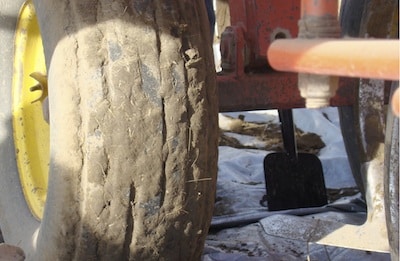
Early detection makes clubroot easier to contain. By the time patches of clubroot infection are obvious in fields, clubroot spores may have been present for a while and may have already spread to neighbouring fields. Clubroot disease management plans will vary depending on the amount of disease and its severity, but growers in all regions should watch for the disease.
Clubroot management for non-infested land
1. Learn to identify the disease. Roots of infected plants become malformed due to increased cell division and growth. Clubroot galls tie up nutrients, and severely infected roots can’t transport adequate water and nutrients to aboveground plant tissues. The best time to scout for clubroot symptoms on roots is late in the season, approximately two weeks before swathing, when root galls should be easy to identify. Click here for more information on how to identify clubroot.
2. Practice good sanitation. Clubroot spreads mainly by movement of soil that contains the hardy resting spores of P. brassicae. Equipment is the key way that clubroot spreads from field to field.
—Step 1: Rough cleaning. This is the most important step. Use a hand scraper, wire brush or compressed air to remove loose and clinging soil and crop debris from openers, tires and wheels. Sweep, blow or scrape off the frame. This should remove at least 90% of the soil from the unit.
—Step 2: Fine cleaning. Use a pressure washer at 2,000 to 3,000 psi on all areas where soil can accumulate. Turbo nozzles are generally more effective at removing soil than regular nozzles.
—Step 3: Disinfection. Disinfect all openers, tires and wheels with a 1% bleach solution or surface disinfectant of equivalent strength. A 3-gallon backpack herbicide sprayer will work for this job. All areas should remain wet with the solution for 15 to 20 minutes. For more detail, download the Clubroot Sanitation Guide.
3. Use a resistant variety. This can keep undetected levels of clubroot from increasing to economically-significant levels.
4. Control weeds. Volunteer canola and susceptible weeds (mustard family, dock, and hoary cress) must be controlled in the rotational crops. If clubroot spores are introduced during non-canola years on a field, these spores have nothing to infect if host weeds and canola volunteers are controlled. With nothing to infect, clubroot cannot reproduce and increase its inoculum levels.
5. Clean newly purchased equipment. Clean used or demo’ed equipment before it leaves the auction site or previous owner’s farm. Also check that the transport truck is clean. As a precaution, you may want to pressure wash the equipment again when it gets to your farm. Do this in a commercial truck wash or on the farm in a low-traffic grassed area away from any cultivated soil.
Clubroot management on land known to have clubroot
1. Minimize traffic in and out of infested fields. Once clubroot is found in a field, the goal is to prevent the introduction of the long-lived resting spores into new fields. Minimize all equipment traffic into infested fields. Service and nurse trucks, for example, should remain on the road and field equipment should be brought to them. Equipment leaving an infested field should be thoroughly cleaned and disinfected.
2. Eliminate tillage. Do not work infested fields when they are wet because more mud will stick to equipment and could be transported to clean fields. Reduced tillage or direct seeding also may help slow the spread of clubroot by reducing the movement of contaminated soil on equipment and by wind.
3. Use resistant varieties. Clubroot-resistant hybrids can provide a significant drop in clubroot infection and severity. Extending the rotation length between canola crops and rotating between the 2 major clubroot resistance suppliers will reduce the risk of clubroot adapting to the resistance gene.
4. Rotate crops. We encourage responsible management of canola rotations. To stop growing canola on land that may be infected with clubroot is not the most effective way to stop the spread of disease. That’s because it can exist for many years. The key is sanitation.
5. Control weeds. Volunteer canola and susceptible weeds (mustard family, dock, and hoary cress) must be controlled in the rotational crops. These volunteers and weeds host clubroot in non-canola years, reducing the effectiveness of rotation as a management tool.
6. Scout. When using resistant varieties, continue to scout for gall formation on plant roots. Low-level infection is normal for these hybrids. Higher incidence levels could signal the start of a breakdown of resistance. While scouting, look for galls on volunteer canola, which may be more susceptible to the disease.
Some Group-14 fungicides are registered to control clubroot in other brassica vegetable crops, but they are not registered for use on canola. Do not use non-registered products on canola. Residues of unregistered products found on exported seed could jeopardize canola markets.
Scenarios
1. If growers identify infested patches within fields, they can contain clubroot within the field with zero tillage and low disturbance seeding to minimize soil movement, and thorough equipment sanitation before leaving the field. Canola could be profitably grown on that farm for many years without requiring clubroot resistant varieties.
2. If nothing is done to manage fields with clubroot (whether presence of the disease is known or unknown), clubroot can be moved throughout the field in a matter of a few years — especially if tillage is regular practice on that field. Canola in a tight rotation on those fields will quickly build up the clubroot population, especially if moisture conditions are also favorable for strong plant growth and high yields. Within two or three rotation cycles, clubroot can be at levels sufficient to completely wipe out a crop. Rotating completely out of canola or relying on clubroot resistant varieties would be the only options. Intensive use of clubroot resistant varieties in fields high in clubroot has been shown in other countries to quickly overcome the clubroot resistance trait.
